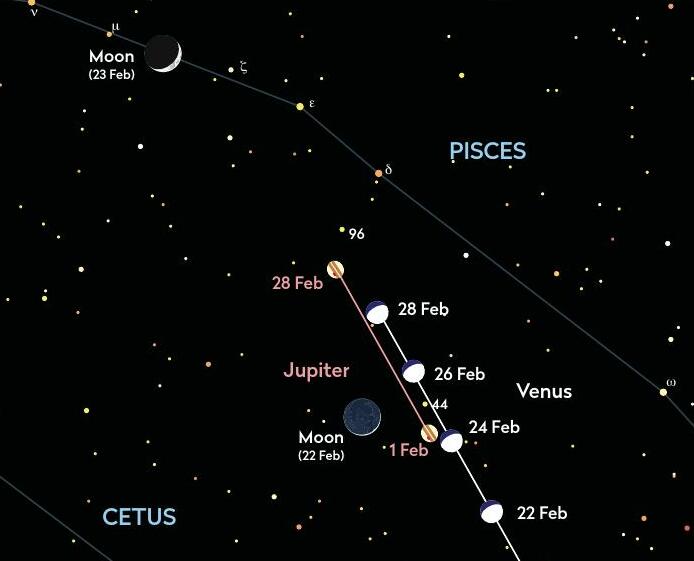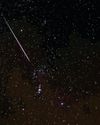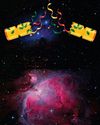試す 金 - 無料
Jupiter
BBC Sky at Night Magazine
|February 2023
Jupiter is rapidly losing ground to the evening twilight, appearing 29° above the southwest horizon under deep twilight conditions at the start of the month, but reaching only 12° above the western horizon by the time we reach the end of the month.
-

Best time to see: 1 February, from 17:30 UT
Altitude: 34°
Location: Pisces
Direction: South-southwest
Features: Complex atmosphere, Galilean moons
Recommended equipment: 75mm or larger
Through the eyepiece of a telescope, Jupiter's low altitude will mean it will be badly affected by seeing. This causes fine detail to wobble and blur, making such detail difficult to see well. On a more encouraging note, Jupiter's declination is increasing, and when next at opposition in early November, it will be able to reach an altitude of 50° in a dark sky.
A small telescope will currently show the planet's disc, two main belts, and, for apertures above 100mm, the persistent atmospheric feature known as the Great Red Spot. The four Galilean moons are another amazing sight to watch as their starlike dots appear to dance endlessly around the planet.
As the end of February approaches and we move into the start of March, mag. -1.9 Jupiter will appear really close to mag. -3.9 Venus, the two planets forming an impressive pair above the western horizon even despite their low altitude. On 28 February, they will appear 1.5° apart, a prelude to their closest separation of just 0.6° on 1 March. If you have several clear evenings, watching a planetary conjunction involving two bright planets is fascinating. The rapid positional shifts really give you a sense of the three-dimensional nature of our Solar System.
On the evening of 22 February, a thin 8%-lit waxing crescent Moon sits south of the imaginary line joining Venus to Jupiter, a particularly striking display and a great scene to photograph if the conditions are clear.
The planets in February
このストーリーは、BBC Sky at Night Magazine の February 2023 版からのものです。
Magzter GOLD を購読すると、厳選された何千ものプレミアム記事や、10,000 以上の雑誌や新聞にアクセスできます。
すでに購読者ですか? サインイン
BBC Sky at Night Magazine からのその他のストーリー

BBC Sky at Night Magazine
How to photograph the Geminids
Dramatic meteor photos aren't just down to luck. We show you how to bag one
3 mins
December 2025

BBC Sky at Night Magazine
10 Christmas crackers for your new telescope
So Santa brought you a telescope - what now? Stuart Atkinson sprinkles some cosmic sparkle, with 10 sights to see over one fabulous festive night - from glorious galaxies and planets to glittering star clusters
7 mins
December 2025

BBC Sky at Night Magazine
10 years of reusable rockets
Ben Evans charts the rise of multi-flight spacecraft, the tech revolution that's transforming our access to space
6 mins
December 2025

BBC Sky at Night Magazine
SKILLS FOR STARGAZERS
Take great photos of the Milky Way
3 mins
December 2025

BBC Sky at Night Magazine
Smart scopes: from backyard to big science
Home-based stargazers are helping scientists crack some of the Universe's big mysteries - and you can join them. Charlotte Daniels shows us how
6 mins
December 2025

BBC Sky at Night Magazine
FIELD OF VIEW
Forget Instagram – embrace the moment
2 mins
December 2025

BBC Sky at Night Magazine
Q&A WITH A PLANETARY LIFE EXPERT
Saturn's icy moon Enceladus boasts water, heat and organics. Now scientists have discovered it has complex chemistry too. Could it prove to be habitable?
3 mins
December 2025

BBC Sky at Night Magazine
INSIDE THE SKY AT NIGHT
When The Sky at Night joined Curious Cases for a special episode, George Dransfield was there to answer your burning questions. Here she dives deeper into her favourite
3 mins
December 2025

BBC Sky at Night Magazine
Students fix JWST's blurry vision
PhD researchers restore the telescope's ultra-precise imaging - without a spacewalk
1 min
December 2025

BBC Sky at Night Magazine
On a Mission
This is an inspiring tribute to the trailblazing women who shaped NASA's human spaceflight programmes.
1 mins
December 2025
Translate
Change font size
